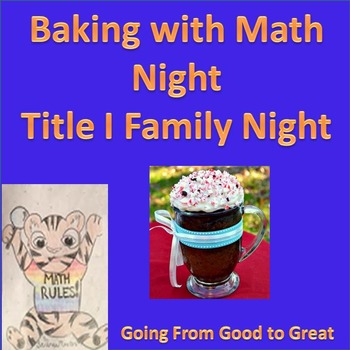Baking with Math Night- Title I Family Night
Going From Good to GREAT
25 Followers
Grade Levels
3rd - 9th
Subjects
Resource Type
Standards
CCSS6.RP.A.1
CCSS6.RP.A.2
CCSS6.RP.A.3
CCSS6.RP.A.3a
CCSS6.RP.A.3b
Formats Included
- PDF
Pages
9 pages
Going From Good to GREAT
25 Followers
Description
During this family night families bake together a mug cake while doing math activities- spliting the recipe, measurements as well as ratios, use percent. In this package you will get the budget, ingredient list, what to get at the grocery store, the math packet along with a parent handout of how they could work with their children at home with mathematics along with answer keys. It aligns very well to the 6th grade standards but can also go along with other grade levels. I do this family night for grades 5 through 8 and get a great turn out!
Total Pages
9 pages
Answer Key
Included
Teaching Duration
N/A
Last updated Dec 21st, 2014
Report this resource to TPT
Reported resources will be reviewed by our team. Report this resource to let us know if this resource violates TPT’s content guidelines.
Standards
to see state-specific standards (only available in the US).
CCSS6.RP.A.1
Understand the concept of a ratio and use ratio language to describe a ratio relationship between two quantities. For example, “The ratio of wings to beaks in the bird house at the zoo was 2:1, because for every 2 wings there was 1 beak.” “For every vote candidate A received, candidate C received nearly three votes.”
CCSS6.RP.A.2
Understand the concept of a unit rate 𝘢/𝘣 associated with a ratio 𝘢:𝘣 with 𝘣 ≠ 0, and use rate language in the context of a ratio relationship. For example, “This recipe has a ratio of 3 cups of flour to 4 cups of sugar, so there is 3/4 cup of flour for each cup of sugar.” “We paid $75 for 15 hamburgers, which is a rate of $5 per hamburger.”
CCSS6.RP.A.3
Use ratio and rate reasoning to solve real-world and mathematical problems, e.g., by reasoning about tables of equivalent ratios, tape diagrams, double number line diagrams, or equations.
CCSS6.RP.A.3a
Make tables of equivalent ratios relating quantities with whole-number measurements, find missing values in the tables, and plot the pairs of values on the coordinate plane. Use tables to compare ratios.
CCSS6.RP.A.3b
Solve unit rate problems including those involving unit pricing and constant speed. For example, if it took 7 hours to mow 4 lawns, then at that rate, how many lawns could be mowed in 35 hours? At what rate were lawns being mowed?





